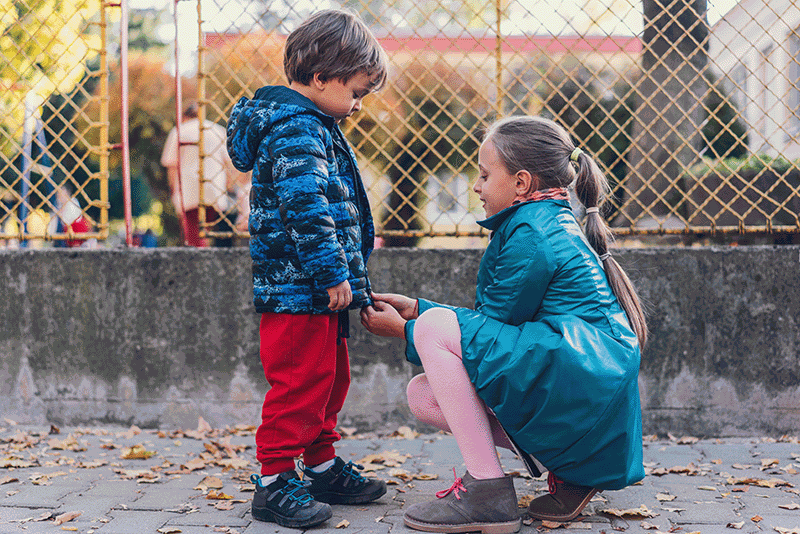Posted: December 12, 2024
Discover how incorporating caring routines in early childhood education can enhance teacher-student relationships. Practicing caring routines help both educators and children thrive by fostering kindness and empathy.

An older child kneels to help a preschooler zip their jacket outside on a playground.
"A growing body of research is demonstrating that by regularly engaging in practices that help us generate a sense of care and compassion for others, we can improve our own lives" (Jennings, 2015, p 115).
Growing kind, caring, and responsive relationships with children and families is at the core of teaching. Caring routines or practices help foster positive teacher/child relationships and interactions and support children's learning. Caring routines are things that educators do to build a community that makes caring and kindness foundational in the early learning setting. The more educators demonstrate care and kindness for others, the easier it becomes to internalize those feelings. Then, educators can boost their capacity to feel compassion, or the ability to recognize another person's need, empathize, and feel motivated to do something to support the individual.
Educator's nurturing and caring interactions with young children enrich their skill development. These responsive interactions create a platform for children to learn about feelings and manage emotions, care for others, and interact in kind ways. The more caring routines that are in place, the more children have an opportunity to see and practice these skills and internalize these values.
Caring routines to put into practice:
- Greet children and families individually and warmly as they arrive each day.
- Say something kind and special to children daily, for example, "I really liked hearing what you did with your grandma this weekend. It sounds like you had fun with her at the library!"
- Use specific language that shows you notice and care about what children do: "You helped Amir when he fell on the playground. You are a good friend!"
- Provide consistent opportunities for children to be in helping roles like setting up for mealtime or picking up toys on the playground.
- Set up developmentally informed routines and structures in the learning environment that help children succeed. For example, help children move through the handwashing transition smoothly, quickly, and successfully by singing interactive songs while they wait.
- Acknowledge children's feelings and support their problem-solving skills. For example, a pre-K educator says, "Priya, it looks like you're feeling frustrated that you can't play with the puzzle you enjoy the most right now. I know you like to figure out how the pieces go together. You also like to create structures. Let's think of another center where you could go to create something. What are your ideas?"
- Read books that support caring, kindness, and friendship, like The Big Umbrella by Amy June Bates, and have conversations with children about what happens in the story and how it relates to their experiences.
Reference: Jennings, Patricia A. (2015). Mindfulness for Teachers: Simple Skills for Peace and Productivity in the Classroom. W.W. Norton & Co.

